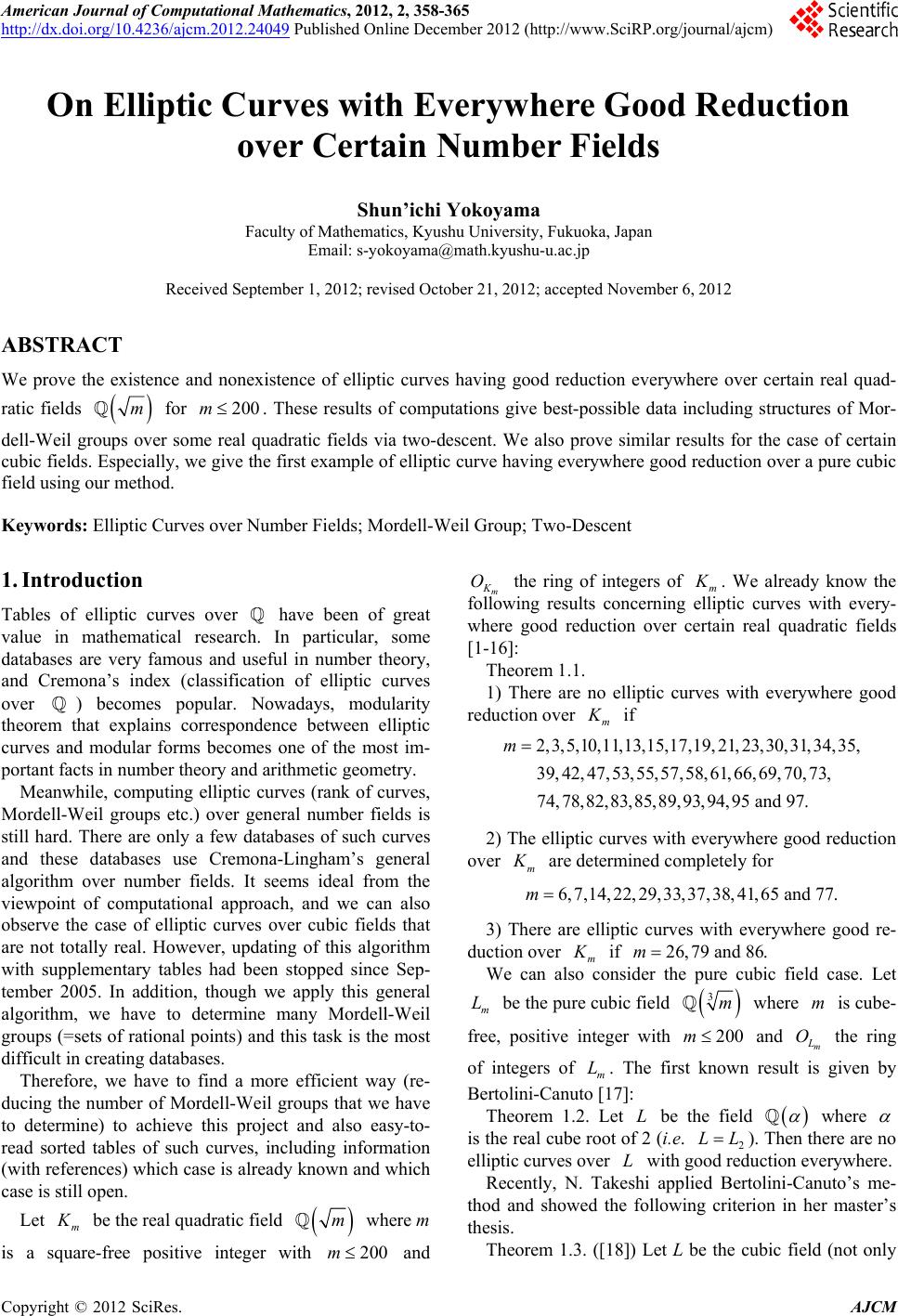 American Journal of Computational Mathematics, 2012, 2, 358-365 http://dx.doi.org/10.4236/ajcm.2012.24049 Published Online December 2012 (http://www.SciRP.org/journal/ajcm) On Elliptic Curves with Everywhere Good Reduction over Certain Number Fields Shun’ichi Yokoyama Faculty of Mathematics, Kyushu University, Fukuoka, Japan Email: s-yokoyama@math.kyushu-u.ac.jp Received September 1, 2012; revised October 21, 2012; accepted November 6, 2012 ABSTRACT We prove the existence and nonexistence of elliptic curves having good reduction everywhere over certain real quad- ratic fields m for . These results of computations give best-possible data including structures of Mor- dell-Weil groups over some real quadratic fields via two-descent. We also prove similar results for the case of certain cubic fields. Especially, we give the first example of elliptic curve having everywhere good reduction over a pure cubic field using our method. 200m Keywords: Elliptic Curves over Number Fields; Mordell-Weil Group; Two-Descent 1. Introduction Tables of elliptic curves over have been of great value in mathematical research. In particular, some databases are very famous and useful in number theory, and Cremona’s index (classification of elliptic curves over ) becomes popular. Nowadays, modularity theorem that explains correspondence between elliptic curves and modular forms becomes one of the most im- portant facts in number theory and arithmetic geometry. Meanwhile, computing elliptic curves (rank of curves, Mordell-Weil groups etc.) over general number fields is still hard. There are only a few databases of such curves and these databases use Cremona-Lingham’s general algorithm over number fields. It seems ideal from the viewpoint of computational approach, and we can also observe the case of elliptic curves over cubic fields that are not totally real. However, updating of this algorithm with supplementary tables had been stopped since Sep- tember 2005. In addition, though we apply this general algorithm, we have to determine many Mordell-Weil groups (=sets of rational points) and this task is the most difficult in creating databases. Therefore, we have to find a more efficient way (re- ducing the number of Mordell-Weil groups that we have to determine) to achieve this project and also easy-to- read sorted tables of such curves, including information (with references) which case is already known and which case is still open. Let m be the real quadratic field m where m is a square-free positive integer with and m 200m O the ring of integers of m . We already know the following results concerning elliptic curves with every- where good reduction over certain real quadratic fields [1-16]: Theorem 1.1. 1) There are no elliptic curves with everywhere good reduction over m if 2, 3, 5,10,11,13,15,171, 23, 30, 31, 34, 35, 39, 42, 47,53,55,57,, 66, 69,70, 73, 74,78,82,83,85,89,,95 and 97. m,19, 2 58,61 93,94 2) The elliptic curves with everywhere good reduction over m are determined completely for 6,7,14,22,29,33,,41,65 and 77.m37,38 3) There are elliptic curves with everywhere good re- duction over m if 26nd 86.m,79 a We can also consider the pure cubic field case. Let m L be the pure cubic field 3 re m is be- free, positive integer with 20m m m whecu and 0 O ring of integers of m L. e first known result is given by Bertolini-Canuto [17]: the Th Theorem 1.2. Let be the field L where is the real cube root of 2 (i.e. 2). Then there are no elliptic curves over with good reduction everywhere. LL L Recently, N. Takeshi applied Bertolini-Canuto’s me- thod and showed the following criterion in her master’s thesis. Theorem 1.3. ([18]) Let L be the cubic field (not only C opyright © 2012 SciRes. AJCM 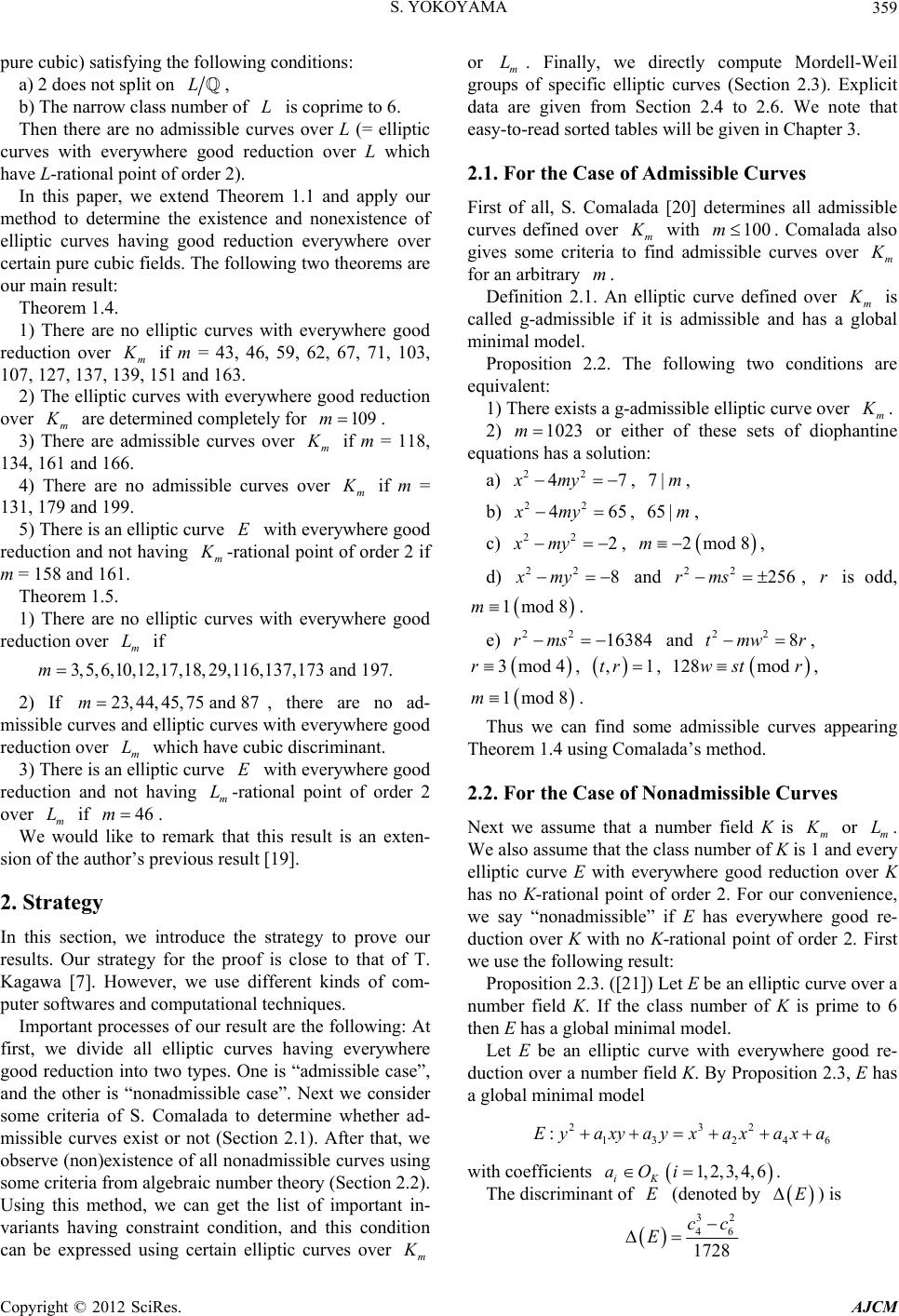 S. YOKOYAMA 359 pure cubic) satisfying the following conditions: a) 2 does not split on L, b) The narrow class number of is coprime to 6. L Then there are no admissible curves over L (= elliptic curves with everywhere good reduction over L which have L-rational point of order 2). In this paper, we extend Theorem 1.1 and apply our method to determine the existence and nonexistence of elliptic curves having good reduction everywhere over certain pure cubic fields. The following two theorems are our main result: Theorem 1.4. 1) There are no elliptic curves with everywhere good reduction over m if m = 43, 46, 59, 62, 67, 71, 103, 107, 127, 137, 139, 151 and 163. 2) The elliptic curves with everywhere good reduction over m are determined completely for . 109m 3) There are admissible curves over m if m = 118, 134, 161 and 166. 4) There are no admissible curves over m if m = 131, 179 and 199. 5) There is an elliptic curve with everywhere good reduction and not having E m -rational point of order 2 if m = 158 and 161. Theorem 1.5. 1) There are no elliptic curves with everywhere good reduction over if m L 3,5,6,10,12,17,18,29,116,137,173 and 197.m 2) If , there are no ad- missible curves and elliptic curves with everywhere good reduction over which have cubic discriminant. 23,44,45,75 and 87m L E m 3) There is an elliptic curve with everywhere good reduction and not having -rational point of order 2 over if . m L m We would like to remark that this result is an exten- sion of the author’s previous result [19]. L46m 2. Strategy In this section, we introduce the strategy to prove our results. Our strategy for the proof is close to that of T. Kagawa [7]. However, we use different kinds of com- puter softwares and computational techniques. Important processes of our result are the following: At first, we divide all elliptic curves having everywhere good reduction into two types. One is “admissible case”, and the other is “nonadmissible case”. Next we consider some criteria of S. Comalada to determine whether ad- missible curves exist or not (Section 2.1). After that, we observe (non)existence of all nonadmissible curves using some criteria from algebraic number theory (Section 2.2). Using this method, we can get the list of important in- variants having constraint condition, and this condition can be expressed using certain elliptic curves over m or m. Finally, we directly compute Mordell-Weil groups of specific elliptic curves (Section 2.3). Explicit data are given from Section 2.4 to 2.6. We note that easy-to-read sorted tables will be given in Chapter 3. L 2.1. For the Case of Admissible Curves First of all, S. Comalada [20] determines all admissible curves defined over m with . Comalada also gives some criteria to find admissible curves over 100m m for an arbitrary . m Definition 2.1. An elliptic curve defined over m is called g-admissible if it is admissible and has a global minimal model. Proposition 2.2. The following two conditions are equivalent: 1) There exists a g-admissible elliptic curve over m . 2) 1023m or either of these sets of diophantine equations has a solution: a) 22 47xmy , , 7|m b) 22 46xmy 5 , , 65|m c) 22 2xmy , , 2mod 8m d) 22 8xmy and , is odd, 22 256rms r od 81mm. e) and , 22 16384rms 22 8tmw r od 4r3m , ,1tr , , 128 modwst r 1mod 8m. Thus we can find some admissible curves appearing Theorem 1.4 using Comalada’s method. 2.2. For the Case of Nonadmissible Curves Next we assume that a number field K is m or . We also assume that the class number of K is 1 and every elliptic curve E with everywhere good reduction over K has no K-rational point of order 2. For our convenience, we say “nonadmissible” if E has everywhere good re- duction over K with no K-rational point of order 2. First we use the following result: m L Proposition 2.3. ([21]) Let E be an elliptic curve over a number field K. If the class number of K is prime to 6 then E has a global minimal model. Let E be an elliptic curve with everywhere good re- duction over a number field K. By Proposition 2.3, E has a global minimal model 232 13 24 :Eyaxy ayxaxax a 6 with coefficients 1, 2, 3,4, 6 iK aOi E . The discriminant of (denoted by E) is 32 46 1728 cc E Copyright © 2012 SciRes. AJCM 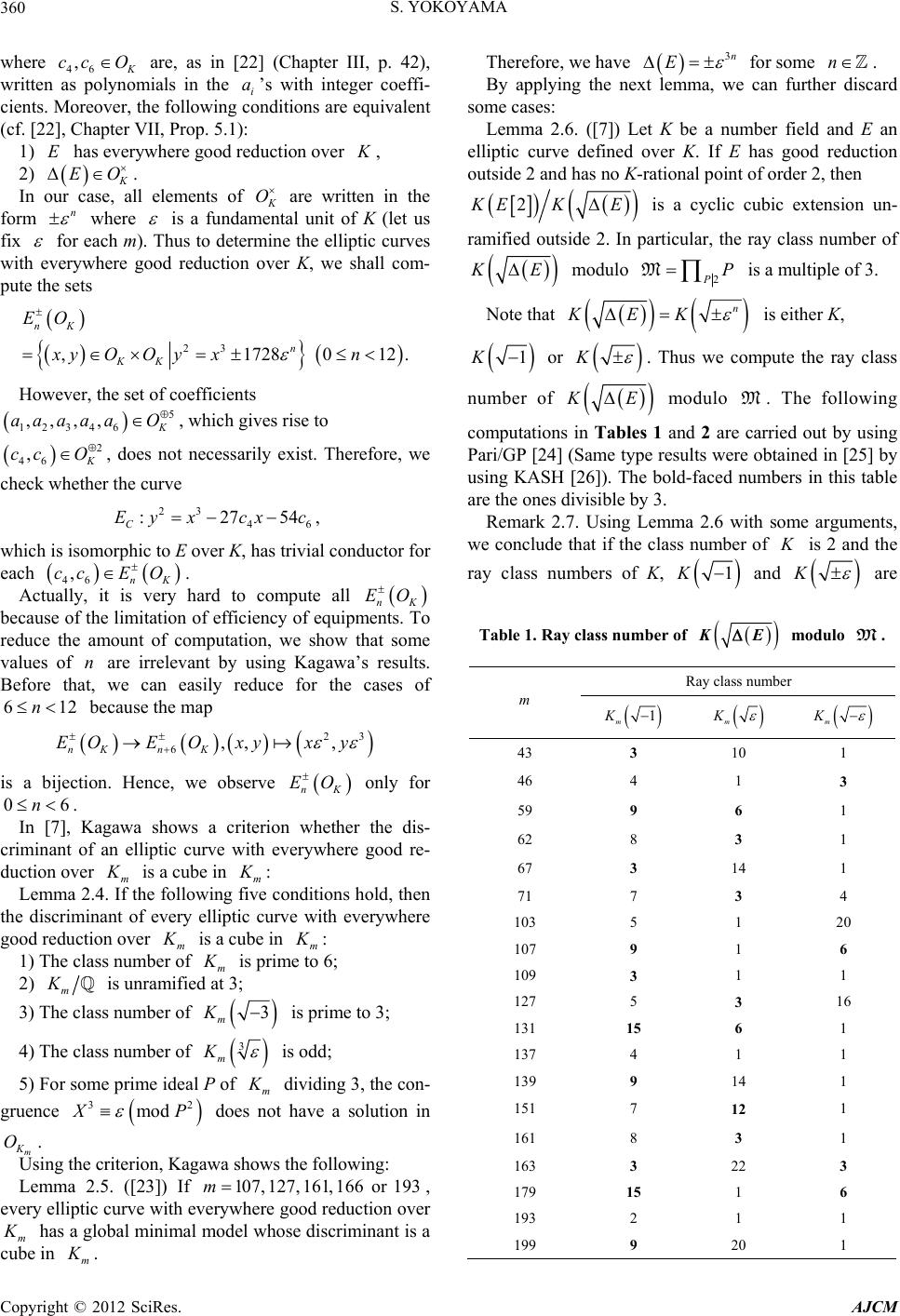 S. YOKOYAMA 360 46 , cc O as polynom where are, as in [22] (Chapter III, p. 42), written ials in the ’s with integer coeffi- i a cients. Moreover, the following conditions are equivalent (cf. [22], Chapter VII, Prop. 5.1): 1) E has everywhere good reduction over K, 2) EO . In our case, all elements of O are written in rm n the fo where is a fundamental unit of ( Klet us fix for each m Thus to determine the elliptic curves with everywhere good reduction over K, we shall com- pute the sets ). , nK EO xy 23 17280 n KK OO yxn However, the set of coefficients 12. 5 12346 ,,,, aa aa aO , which gives rise to 2 46 , cc O , does not necessarily exist. Therefore, we check whether the curv er K, has trivial conductor for each Actu hard to compute all e 23 46 :2754 C Ey xcxc, which is isomorphic to E ov 46 ,nK ccEO . ally, it is very EO hat some results. nK because of the limitation of efficiency of equipments. To reduceom the amount of cputation, we show t values of n are irrelevant by using Kagawa’s Before that, we can easily reduce for the cases of 612n because the map 23 6,, , nKnK EOEOxyx y ion. Hence, we obsis a bijecterve only for whether erywher duct nK EO 06n. In [7], Kagawa shows a criterion the dis- criminant of an elliptic curve with eve good re- verion o m is a cube in m : Lemma 2.4. If the following five conditions hold, then the discriminant of every elliptic curve with everywhere good reductiover n om is a cube in m : 1) The class number of m is prime to 6; 2) m K is unramified at 3; 3) The class number of K3 is prime to m 3; he cla4) Tss number of 3 m K is odd; P of 5) For some prime idealm dividing 3, the con- gruence 32 mod P ot have a does nsolution in m O. Using wa shows the following: Lemm 107,127,161,166 or 193 the criterion, Kaga a 2.5. ([23]) If m , with everywhere good reduction over every elliptic curve m has a global minimal model whose discriminant is a be in m cu . Therefore, we have 3n E for some n . y applying the next lemma, we can further discard some cas B es: et K be a nund En el has no K-rational point of order 2, then Lemma 2.6. ([7]) Lmber field a a liptic curve defined over K. If E has good reduction outside 2 and 2 EKE is a cyclic cubic extension un- ramified outside 2. In particular, the ray class number of E modulo 2PP M is a multiple of 3. Note that n KEK is either K, 1K or K . Thus we compute the ray class number of E modulo computan Table s (Same typee o 26]). The um M. The following tions i 1 and 2 are carried out by using Pari/GP [24] results werbtained in [25] by using KASH [bold-faced nbers in this table are the ones divisible by 3. Remark 2.7. Using Lemma 2.6 with some arguments, we conclude that if the class number of K is 2 and the ray class numbers of K, 1K and K are of Table 1. Ray class number KE m. odulo Ray class number M m 1K m K m K m 43 3 1 10 46 4 1 3 103 5 20 107 15 6 12 15 59 9 6 1 62 8 3 1 67 3 14 1 71 7 3 4 1 1 9 6 109 127 5 3 1 1 3 16 131 1 137 4 1 1 139 9 14 1 151 7 1 161 8 3 1 163 3 22 3 179 193 2 1 1 6 1 199 9 20 1 Copyright © 2012 SciRes. AJCM 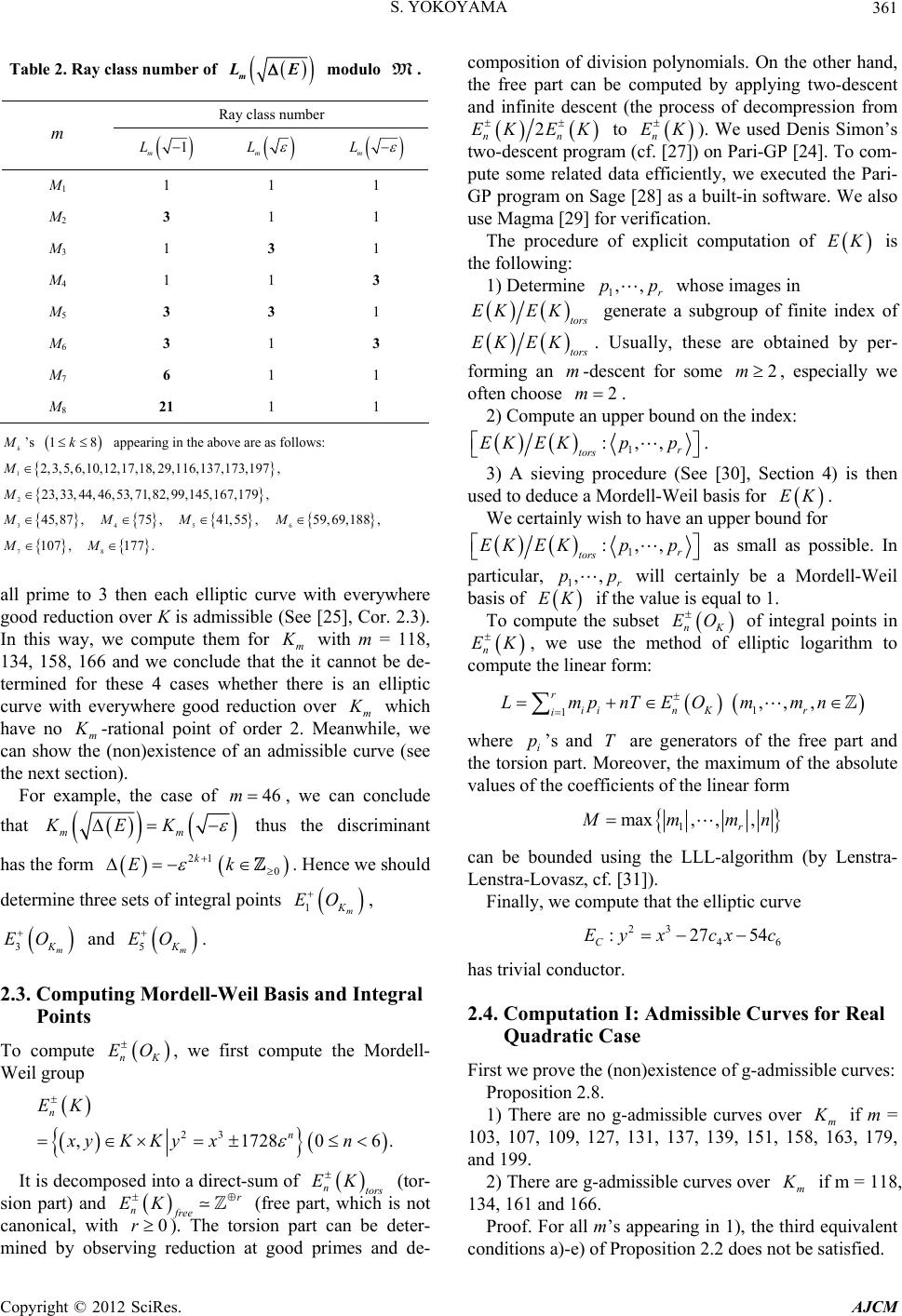 S. YOKOYAMA 361 m LE Table 2. Ray class number of modulo Ray class number M. m 1 m L m L m L M1 1 1 1 M2 3 1 1 M3 1 3 1 M1 3 M5 3 3 1 4 1 M6 3 1 3 M7 6 1 1 M8 21 1 1 k ’s appearing in the above are aollows: 1k8 s f 12,6,10,12,17,18,216,137,173,197M 3,5, 9,1, 2244, 46,53, 71, 829,145,167,179,M3,33, ,9 34 ,M 5,87 475 ,M 541,55 ,M 659,69,188, M 7107 ,M 8177 .M all prime to 3 everywhere good reduction over K is admissible (See [25], Cor. 2.3). In this way, we compute them for then each elliptic curve with m with m = 118, 134, 158, 16 and wenclude thit cannot termined for these 4 cases whether tere is an elliptic curve with everywhere good reduer 6 coatbe de- the h ction ovm which ave noh m -rational point of ordeMewhile, we w r 2. an can show the (non)existence of an admissible curve (see the next section). For example, the case of 46me can conclude that , mm KEK thus the discriminant has the form 21 0 k Ek . Hence should determine three sets of integral points 1m K EO , E we omputing Mordell-We pute the dell- 3m K O and 5m K EO . 2.3. Cil Basis and Integral Points To compute nK EO , we first comMor Weil group 23 ,172806. n xy K Kyxn is decom n EK It posed into a direct-sum of (tor- it rsion pa deter- mined by observing reduction at good primes and de- composition of division polynomials. On the other hand, the free part can be computed by applying two-deent and infinite descent (the process of decompression from ntors EK rt can be sion part) and r free (free part, which is not canonical, w n EK h 0r). The to sc 2 nn K EK to E n EK). We usedmon’s two-descent program . [27]) on Pari-GP [24]. To com- pute some related data efficiently, we executed the Pari- GP program on Sage [28] as a built-in software. We also use Magma [29] for verification. The procedure of explicit computation of (cf Denis Si EK is the following: 1) Determine 1,,ppose images in r wh tors EK EK generate a subgroup of finite index of tors EK EK. Usually, these are obtained by per- forming an m-descent for some 2m, especially we often choose 2m . 2) Compute an upper bound on the index: 1 p:,, r tors K EKpE . 3) A sieving used to deduce a M We certainly w procedure (See [30], Section 4) is then ordell-Weil basis for EK. ish to have an upper bound for 1 :,, r r EK EKpp to s as as possible. In pa small ordell-Weil basis of rticular, 1,, r pp will certainly be a M EK if the value is equal to 1. To coof integral points in mpute the subset nK EO nK , we use the method of elliptic logarithm to compute the linear form: E r 1,, , K r mmn 1ii n i LmpnTEO where i p’are generators of the free part and the torsio. Moreover, the maximum o s and partf the absolute va the line T n lues of the coefficients ofar form 1 max, ,, r mmn can be bounded using the LLL-algorithm (by Lenstra- Lenstra-Lovasz, cf. [31]). ly p Fible curves: Proposition 2.8. 1) There are no g-admissible curves over Final, we comute that the elliptic curve 23 46 :2754 C Ey xcxc has trivial conductor. 2.4. Computation I: Admissible Curves for Real Quadratic Case rst we prove the (non)existence of g-admissi m if m = 1, 137, 139, 151, 15, 179, and 199. 103, 107, 109, 127, 138, 163 2) There are g-admissible curves over m if m = 118 161 and 166. , 134, Proof. For all m’s appearing in 1), the third equivalent conditions a)-e) of Proposition 2.2 does not be satisfied. Copyright © 2012 SciRes. AJCM 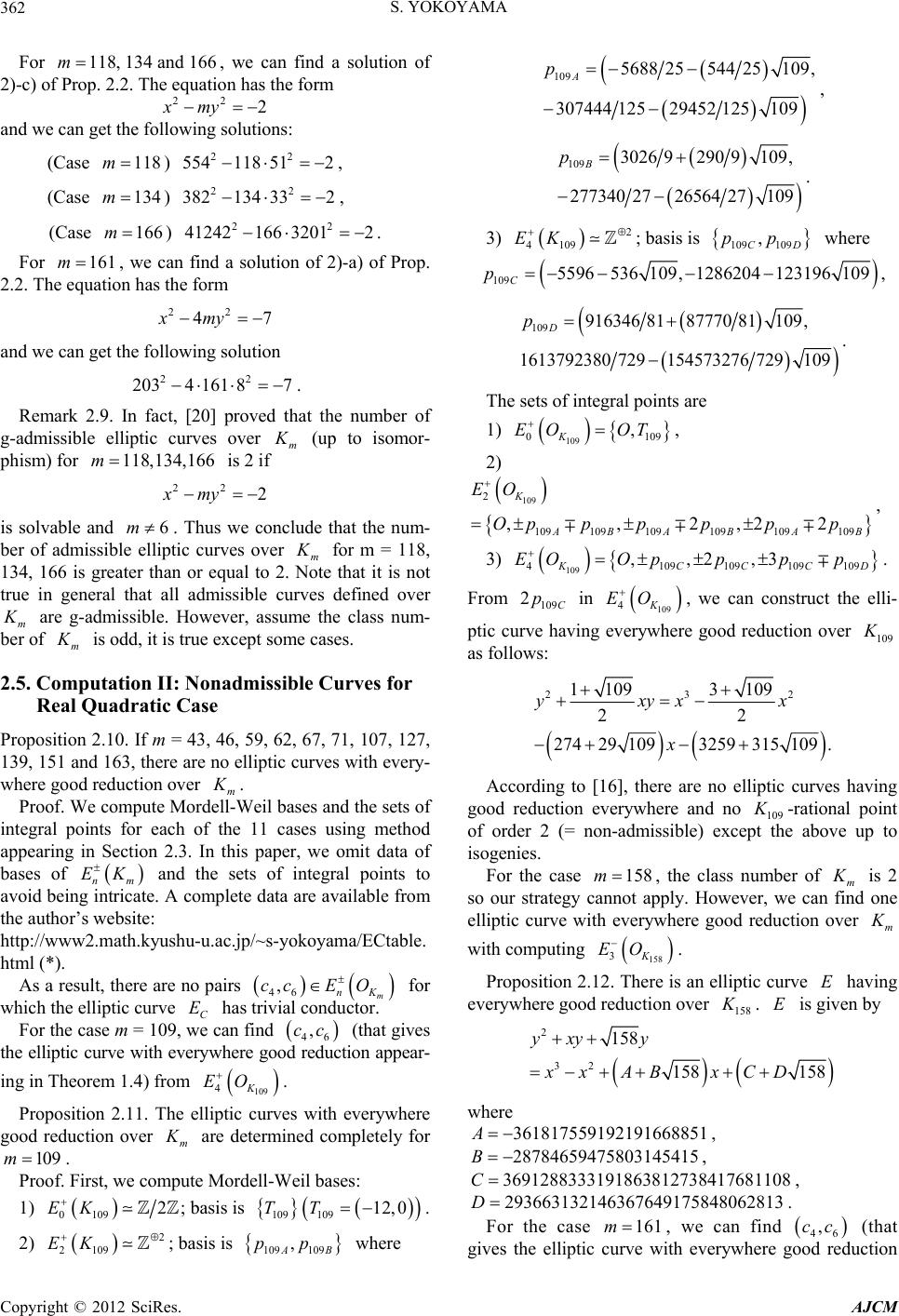 S. YOKOYAMA 362 For 118, 134m and 166, we can find a solution of 2) n get the -c) of Prop. 2.2. The equation has the form 22 2xmy and we cafollowing solutions: (Case 118m) 22 554118512 , (Case 134m) 22 382134332 , Case 166m) 22 4124 (216632012 . For 161m, we can find a solution of 2)-a) of Prop. 2.2. The equation has the form and we can get the following solution Rem9. In fa20] proved that the numer of g-sible e 22 47xmy 2 2 2034161 87. ark 2.ct, [b admislliptic curves over m (up to isomor- phism) for 118,134, 166m is 2 lude that the num- ber of admissible elliptic curves over if 22 2xmy is solvable and 6m. Thus we conc m ote for m = 118, 134, 166 is gror equal to 2. that it is not tru eater than N e in general that all admissible curves defined over m are g-admissible. However, asse the class num- ber of m um is odd, it is true except som cases. 2.5. Computation II: Nonadmissible Curves for e Real Quadratic Case Proposition 2.10. If m = 43, 46, 59, 62, 67, 71, 107, 127, 139, 151 and 163, there are no elliptic curves with every- where good reduction over m . Proof. We compute Mordell-Weil bases and the sets of integraints for each of the 11 cases usingl po method f o avoi ailable from curve w appearing in Section 2.3. In this paper, we omit data o bases of nm EK and the sets of integral points t d being intricate. A complete data are av the author’s website: http://www2.math.kyushu- u.ac.jp/~s-yokoyama/ECtab le. html (*). As a result, there are no pairs 46 ,m nK ccE O for which the elliptic curve C E has trivial conductor. For the case m = 109, we can find 46 ,cc (that gives the elliptic ith everywhere good reduction appear- ing in Theorem 1.4) from 109 4K EO . Proposition 2.11. The elliptic curves with everywhere good reduction over m are determined completely for m109. Proof. First, we compu Mordell-Weil bases: te 1) 0 1092EK ; basis is 10 12,0TT . 2) 2 EK ; basis is ,pp where 9 109 2109 109 109AB 307444 12529452 125109 , 109 5688 5 A p 25544 2109, 7109 109 3026 9290 9109, B p . 277340 2726564 2 3) 2 4 109 EK ; basis is where 109 109 , CD pp 109 6 109,1296 109p55965386204 1231 C , 109 916346 818777081109, 1613792380 729154573276 729109 D p . The sets of integral points are 1) 109 0 109 , K EO OT , 2) 109 2 109 109109109109109 ,,2,22 K ABABAB EO Oppp pp p , 109 4109 109 1099 ,,2,3 KCCC EOOpppp . 3) 10 D From in 109 2C p 109 4K EO , we can construct the elli- ptod reduction over ic curve having everywhere go109 as follows: 23 1 1093 109 22 27429 1093259315109. yxyxx x 2 ording to [16], there are no elliptic curves having goeduction everywhere and no Acc od r109 -rational poi er 2 (-admissib nt of ord= nonle) except the above up to isogenies. For the case 158m , the class number of m is 2 gypply. However, we can one elliptic curvehere good reduct so our strate cannot a with everyw find ion over m with computing 158 3K EO . Proposition 2.12. There is an elliptic curve having everywhere good reduction over E 158 . E is n by give 2 32 158 158 158 yxyy xx ABxCD where 361817559192191668 851A , 287846594758031 45415B , 3691288333C19186381273841 7681108 , 29366313214636 764917584806 2813D . For the case 161m , we can find 46 ,cc (that gives the elliptic curve with evererood reductionywhe g Copyright © 2012 SciRes. AJCM 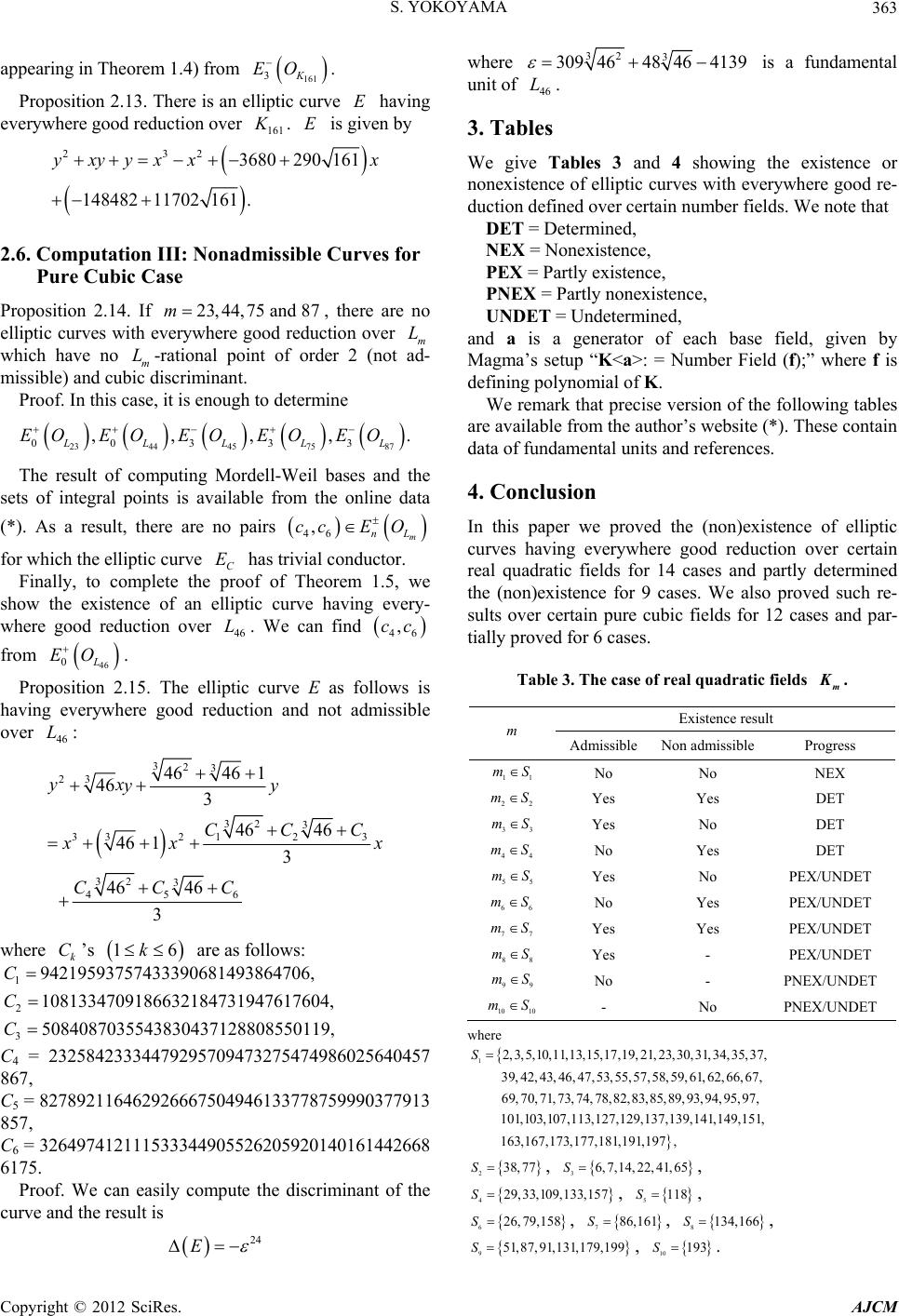 S. YOKOYAMA 363 appearing in Theorem 1.4) from Proposition 2.13. There is an elliptic curve ving everywhere good reduction over 161 3K EO . E ha 161 . E is n by give 232 3680290 161 14848211702161 . yxyyxxx 2.n III: Curve ere are no el o Proof. In this case, it is enough to determine 6. ComputatioNonadmissible s for Pure Cubic Case Proposition 2.14. If 23,44,7m th5 and 87, t ord liptic curves with everywhere good reductionver m L which have no m L-rational poinf oer 2 (not ad- missible) and cubic discriminant. 23 44 45 75 87 00333 ,,,, LLLLL EO EO EO EO EO . (*). e no pairs The result of computing Mordell-Weil bases and the sets of integral points is available from the online data As a result, there ar 46 ,ccEO m nL for which the elliptic curve C E has trivial conductor. Finally, to complete the proof of Theorem 1.5, we show the existence of an elliptic curve having every- wh ere good reduction over 46 L. We can find 46 ,cc from Proposition 2.15. The elliptic curve E as follows is ha . 46 0L EO ving everywhere good reduction and not admissible over 46 L: 323 234646 1 323 32 312 3 46 46 46 13 CCC 33 45 6 46 46 2 46 3 yx y y 3 xx CC C C4 = 23258423334479295709473275474986025640457 867, C5 = 827892116462926667504946133778759990377913 857, C6 = 326497412111533344905526205920140161442668 6175. f. Wcan easily iminant of the curve and the result is where k C’s 16k are as follows: 1 C94219593757433390681493864706, 2108133470918663218473194 7617604,C 350840870355438304 371288085501 19,C Prooe compute the discr 24 E 323 309 4648 464139 where is a ndamental fined over certain number fields. We note that e, PEX = Partly existence, PNEX = Partly nonexistence, ET = Undetermined, is generator of each base field, given by Magma’s setup “K<a>: = Number Field (f);” where f is nomial of K. 4. In he (non)existence of elliptic cu reduction over certain reases and partly determined Existence result fu unit of 46 L. 3. Tables We give Tables 3 and 4 showing the existence or nonexistence of elliptic curves with everywhere good re- duction de DET = Determined, NEX = Nonexistenc UND and a a defining poly We remark that precise version of the following tables are available from the author’s website (*). These contain data of fundamental units and references. Conclusion this paper we proved t rves having everywhere good al quadratic fields for 14 c the (non)existence for 9 cases. We also proved such re- sults over certain pure cubic fields for 12 cases and par- tially proved for 6 cases. Table 3. The case of real quadratic fields m K. m AdmissibleNon admissible Progress 11 mS No No NEX 22 mS Yes Yes DET 33 mS Yes No DET 44 mS No Yes DET 55 mS Yes No PEX/UNDET mS 66 No Yes PEX/UNDET 7 m7 S Yes Yes PEXDE/UNT 88 mS Yes - PEX/UNDET 99 mS No - PNEX/UNDET PN 10 10 mS - No EX/UNDET where 12,3,5,,11,13,19, 21, 23,30,35,37, 39, 42, 43, 46, 47, 57,58, 59, 666, 67, 69,70,,73,74,2,83,85,89,9,97, 101,103,107, 113,127,129,137,139,141, 149,151, 163,16 173,17791, S 197 , 105,17,131, 34, ,53,551, 62, 7178,83, 94, 95 7, ,181,1 238,77S, 34, 22, 41, 65S6, 7,1, 429,33, 09,133,15S17 , 5118S, 626, 7958S, ,1 786,161S, 8134,166S, 951,87,91, 131, 17S, 9,199 10 193S. Copyright © 2012 SciRes. AJCM 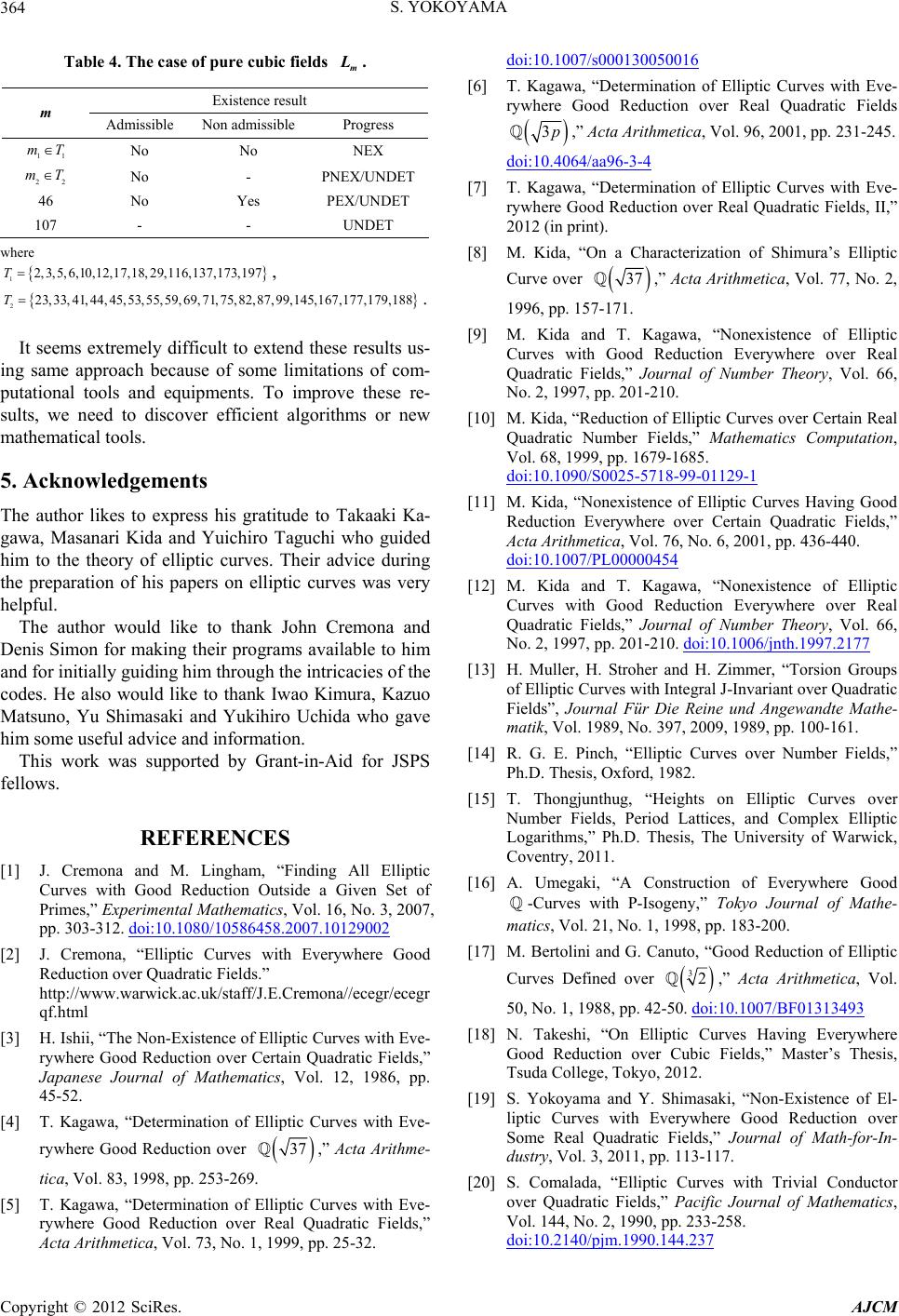 S. YOKOYAMA 364 Table 4. The case of s Existence result pure cubic fieldm L. m Admible Nonissible iss admProgress 11 mT No No NEX 22 mT No - PNEX/UNDET 46 No Yes PEX/UNDET 107 - - UNDET where 12, 3, 5, 6,12,17,18, 29,116,137,1797T, 10, 3,1 223,33,41, 44,45,53,5559,69,71,752,87,99,145,167,177,179,188T. , ,8 It seems extremely difficult toxtendhese results us- ing samof com- putationese re sults, we need to discoverrithms or new mathatical t 5. Acknowledgements The author likes to express his gawaasanari Kida and Yuichiro Taguch hime theoryf elliptic curves. Their advice during eparation of his papers on elliptic curves was very helpful. The author would like to thank John Cremona an enis Simon for making their programs available to him an pported by Grant-in-Aid for JSPS fellows. 03-312. doi:10.1080/10586458.2007.10129002 e om t e approach because of se limitations al tools and equipments. To improve th- efficient algo emools. gratitude to Takaaki Ka- i whded , M to th o gui o the pr d D d for initially guiding him through the intricacies of the codes. He also would like to thank Iwao Kimura, Kazuo Matsuno, Yu Shimasaki and Yukihiro Uchida who gave him some useful advice and information. This work was su REFERENCES [1] J. Cremona and M. Lingham, “Finding All Elliptic Curves with Good Reduction Outside a Given Set of Primes,” Experimental Mathematics, Vol. 16, No. 3, 2007, pp. 3 [2] uadratic F agawa, “Determination of Elliptic Curves with rywhere Good J. Cremona, “Elliptic Curves with Everywhere Good Reduction over Quadratic Fields.” http://www.warwick.ac.uk/staff/J.E.Cremona//ecegr/ecegr qf.html [3] H. Ishii, “The Non-Existence of Elliptic Curves with Eve- rywhere Good Reduction over Certain Qields,” Japanese Journal of Mathematics, Vol. 12, 1986, pp. 45-52. [4] T. KEve- Reduction over 37 998, pp. 253-269. ,” Acta Arithme- tica, Vol. 83, 1 [5] T. Kagawa, “Determination of Elliptic Curves with Eve- rywhere Good Reduction over Real Quadratic Fields,” Acta Arithmetica, Vol. 73, No. 1, 1999, pp. 25-32. doi:10.1007/s000130050016 [6] T. Kagawa, “Determination of Elliptic Curves with Eve- rywhere Good Reduction over Real Quadratic Fields 3p,” Acta Arithmetica, Vol. 96, 2001, pp. 231-245. doi:10.4064/aa96-3-4 [7] T. Kagawa, “Determination of Elliptic Curves with Eve- rywhere Good Reduction over Real Quadratic Fields, II,” 2012 (in print). [8] M. Kida, “On a Characterization of Shimura’s Elliptic Curve over 37,” Acta Arithmetica, Vol. 77, No. 2, Real f Number Theory, Vol. 66, . 8-99-01129-1 1996, pp. 157-171. [9] M. Kida and T. Kagawa, “Nonexistence of Elliptic Curves with Good Reduction Everywhere over Quadratic Fields,” Journal o No. 2, 1997, pp. 201-210. [10] M. Kida, “Reduction of Elliptic Curves over Certain Real Quadratic Number Fields,” Mathematics Computation, Vol. 68, 1999, pp. 1679-1685 doi:10.1090/S0025-571 , Vol. 76, No. 6, 2001, pp. 436-440. [11] M. Kida, “Nonexistence of Elliptic Curves Having Good Reduction Everywhere over Certain Quadratic Fields,” Acta Arithmetica doi:10.1007/PL00000454 [12] M. Kida and T. Kagawa, “Nonexistence of Elliptic Curves with Good Reduction Quadratic Fields,” Journal o Everywhere over Real f Number Theory, Vol. 66, No. 2, 1997, pp. 201-210. doi:10.1006/jnth.1997.2177 [13] H. Muller, H. Stroher and H. Zimmer, “Torsion Groups of Elliptic Curves with Integral J-Invariant over Quadratic Fields”, Journal Für Die Reine und Angewandte Mathe- tic matik, Vol. 1989, No. 397, 2009, 1989, pp. 100-161. [14] R. G. E. Pinch, “Elliptic Curves over Number Fields,” Ph.D. Thesis, Oxford, 1982. [15] T. Thongjunthug, “Heights on Elliptic Curves over Number Fields, Period Lattices, and Complex Elliptic Logarithms,” Ph.D. Thesis, The University of Warwick, Coventry, 2011. [16] A. Umegaki, “A Construction of Everywhere Good -Curves with P-Isogeny,” Tokyo Journal of Mathe- matics, Vol. 21, No. 1, 1998, pp. 183-200. [17] M. Bertolini and G. Canuto, “Good Reduction of Ellip Curves Defined over 32,” Acta Arithmetica, Vol. 50, No. 1, 1988, pp. 42-50. doi:10.1007/BF01313493 [18] N. Takeshi, “On Elliptic Curves Having Everywhere Good Reduction over Cubic Fields,” Master’s Thesis, Tsuda College, Tokyo, 2012. [19] S. Yokoyama and Y. Shimasaki, “Non-Existence of El- liptic Curves with Everywhere Good Reduction over Some Real Quadratic Fields,” Journal of Math-for-In- dustry, Vol. 3, 2011, pp. 113-117. [20] S. Comalada, “Elliptic Curves with Trivial Conductor over Quadratic Fields,” Pacific Journal of Mathematics, Vol. 144, No. 2, 1990, pp. 233-258. doi:10.2140/pjm.1990.144.237 Copyright © 2012 SciRes. AJCM 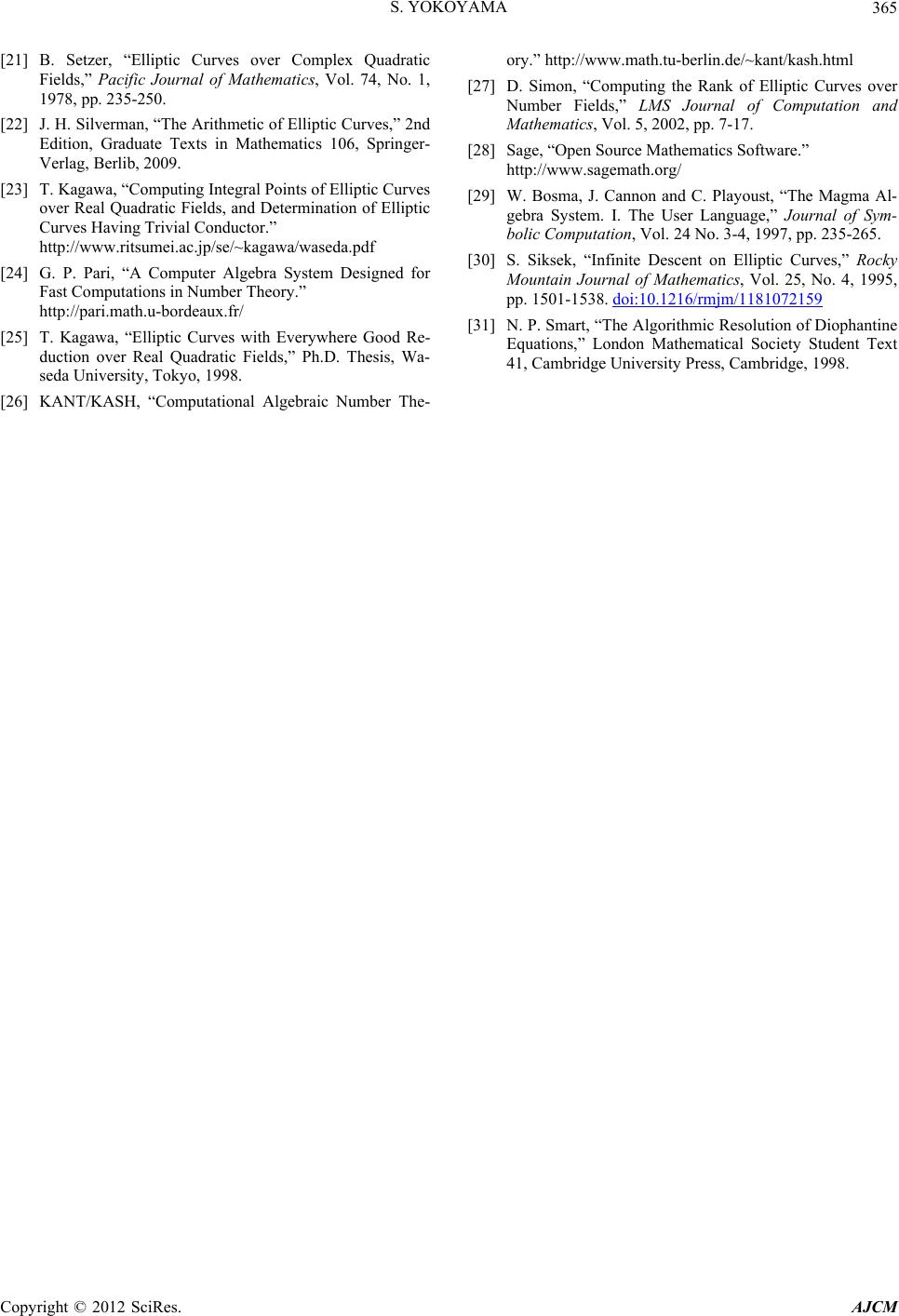 S. YOKOYAMA Copyright © 2012 SciRes. AJCM 365 ral Points of Elliptic Curv System Designed for rywhere Good Re- elds,” Ph.D. Thesis ptic Curves over al of Computation and Sym- ol. 25, No. 4, 1995, [21] B. Setzer, “Elliptic Curves over Complex Quadratic Fields,” Pacific Journal of Mathematics, Vol. 74, No. 1, 1978, pp. 235-250. [22] J. H. Silverman, “The Arithmetic of Elliptic Curves,” 2nd M Edition, Graduate Texts in Mathematics 106, Springer- Verlag, Berlib, 2009. [23] T. Kagawa, “Computing Integes [ over Real Quadratic Fields, and Determination of Elliptic Curves Having Trivial Conductor.” http://www.ritsumei.ac.jp/se/~kagawa/waseda.pdf [24] G. P. Pari, “A Computer Algebra boli Fast Computations in Number Theory.” http://pari.math.u-bordeaux.fr/ [25] T. Kagawa, “Elliptic Curves with Eve duction over Real Quadratic Fi , Wa- seda University, Tokyo, 1998. [26] KANT/KASH, “Computational Algebraic Number The- ory.” http://www.math.tu-berlin.de/~kant/kash.html [27] D. Simon, “Computing the Rank of Elli Number Fields,” LMS Journ athematics, Vol. 5, 2002, pp. 7-17. [28] Sage, “Open Source Mathematics Software.” http://www.sagemath.org/ 29] W. Bosma, J. Cannon and C. Playoust, “The Magma Al- gebra System. I. The User Language,” Journal of c Computation, Vol. 24 No. 3-4, 1997, pp. 235-265. [30] S. Siksek, “Infinite Descent on Elliptic Curves,” Rocky Mountain Journal of Mathematics, V pp. 1501-1538. doi:10.1216/rmjm/1181072159 [31] N. P. Smart, “The Algorithmic Resolution of Diophantine Equations,” London Mathematical Society Student Text 41, Cambridge University Press, Cambridge, 1998.
|